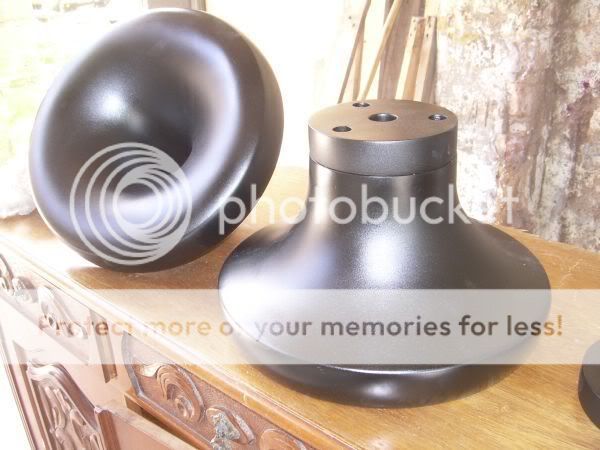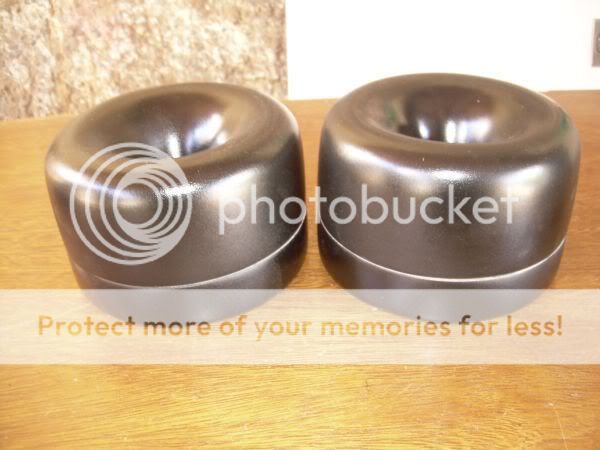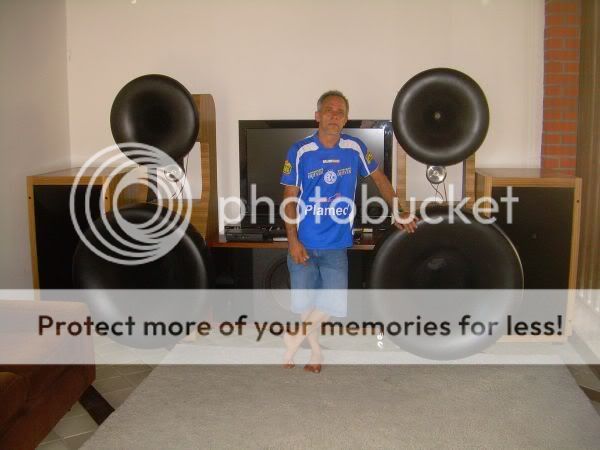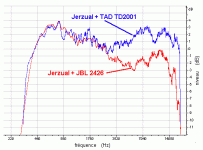hello
stuck ( massa plastica in portuguese ) is applied on all the surface of the horn.
http://www.crayvalley.com.br/produtos/massa/produtos.php#5
we use two different kinds of stuck. since we use brazilian products, you will have to find the equivalent in the u.k. If you go to a car painter, he will be able to give you the right information of what products to use. no mdf layers will remain visible:

after that comes grinding , up until the wanted profile with close tolerance is achieved :

with a mold you can check if the profile is according to the drawing.
i have used a wood mold, but the best is a thin metal sheet of about 2mm, which you cut to have the exact negative of the horn flare. This alouds to get a high precision of > 1mm .

after that you use primer, and finally comes painting. There are horns, i made more than 6 month back, and these continue perfect.
It is important as well that you use wood sticks to fix the mdf layers together, so that these won't move and change position with time :

Angelo
stuck ( massa plastica in portuguese ) is applied on all the surface of the horn.
http://www.crayvalley.com.br/produtos/massa/produtos.php#5
we use two different kinds of stuck. since we use brazilian products, you will have to find the equivalent in the u.k. If you go to a car painter, he will be able to give you the right information of what products to use. no mdf layers will remain visible:

after that comes grinding , up until the wanted profile with close tolerance is achieved :

with a mold you can check if the profile is according to the drawing.
i have used a wood mold, but the best is a thin metal sheet of about 2mm, which you cut to have the exact negative of the horn flare. This alouds to get a high precision of > 1mm .

after that you use primer, and finally comes painting. There are horns, i made more than 6 month back, and these continue perfect.
It is important as well that you use wood sticks to fix the mdf layers together, so that these won't move and change position with time :

Angelo
Bondo?angeloitacare said:
stuck ( massa plastica in portuguese ) is applied on all the surface of the horn.
Angelo
Many thanks for the info - and again, the horns look great.
Surely you must have to put quite a thick layer of the filler onto the MDF, otherwise it would just crack and fall off?
There have been discussions on sealing MDF here before, and someone mentioned that these fillers don't tend to work well on MDF. The reason is because MDF absorbs one of the chemicals in the filler, so the filler doesn't properly cure. However, if you've got horns that are perfect after 6 months, it must be OK.
I've used auto fillers on MDF to cover nails and other imperfections, but I've never spread it onto a smooth surface. I'll give it a try at some point.
Surely you must have to put quite a thick layer of the filler onto the MDF, otherwise it would just crack and fall off?
There have been discussions on sealing MDF here before, and someone mentioned that these fillers don't tend to work well on MDF. The reason is because MDF absorbs one of the chemicals in the filler, so the filler doesn't properly cure. However, if you've got horns that are perfect after 6 months, it must be OK.
I've used auto fillers on MDF to cover nails and other imperfections, but I've never spread it onto a smooth surface. I'll give it a try at some point.
WOODEN SPHERICAL HORNS FOR SALE
Hello,
I disappointed myself with LeCleac'h horns.
They are 1 pair for medium and 1 pair for treble.
Diameter in the mouth of entrance of the throat: 25 mm
Its dimensions of the exit mouth and length are not adjusted to my system.


Victório Benatti
Hello,
I disappointed myself with LeCleac'h horns.
They are 1 pair for medium and 1 pair for treble.
Diameter in the mouth of entrance of the throat: 25 mm
Its dimensions of the exit mouth and length are not adjusted to my system.


Victório Benatti
Hello Vitorio,
I am a bit surprised by you comments. Harshness is something that nobody should experience with the Le Cléac'h horn.
The Le Cléac'h horn is a crual revelator of the weaknesses of the loudspeakers and are very sensitive to their setup so I think that may be your system was not properly set up..
1) the axis of the medium horn should be nearer of the axis of the bass loudspeaker (the mouth of the horn should not be at more than 3 - 5 centimeters from the exterrnal part of the bass loudspeaker;
2) the horn seems a bit too small if you want to cut lower than 800Hz
3) the tweeter horn should not be on the side of the medium horn
3) the system lacks a good time alignment (you need a digital crossover to perfom that). Harshness source may be due to some interference between your tweeter horn and your medium horn.
4) due to their response showing a step, the JBL2426 are not the best compression drivers to use with a Le Cléac'h horn (the JBL drivers are designed to be used with a JBL horn...).
Did you measured the impulse reponse of your system?
Best regards from Paris, France
Jean-Michel Le Cléac'h
I am a bit surprised by you comments. Harshness is something that nobody should experience with the Le Cléac'h horn.
The Le Cléac'h horn is a crual revelator of the weaknesses of the loudspeakers and are very sensitive to their setup so I think that may be your system was not properly set up..
1) the axis of the medium horn should be nearer of the axis of the bass loudspeaker (the mouth of the horn should not be at more than 3 - 5 centimeters from the exterrnal part of the bass loudspeaker;
2) the horn seems a bit too small if you want to cut lower than 800Hz
3) the tweeter horn should not be on the side of the medium horn
3) the system lacks a good time alignment (you need a digital crossover to perfom that). Harshness source may be due to some interference between your tweeter horn and your medium horn.
4) due to their response showing a step, the JBL2426 are not the best compression drivers to use with a Le Cléac'h horn (the JBL drivers are designed to be used with a JBL horn...).
Did you measured the impulse reponse of your system?
Best regards from Paris, France
Jean-Michel Le Cléac'h
You can experience harshness with *any* horn if you don't use a proper crossover.
Mid/high and low/mid acoustical phase must be matched across the crossover regions by means of delay, parametric EQ and phase shifters. Matching group delays is even more effective since the actual goal is to match "transient response" across the crossover region.
I recommend 24dB/oct LR electrical crossover and two "conjugate" phase shifters to achieve 36dB/oct acoustical crossover (the natural 12dB/oct horn roll-off must be always taken into account).
Every horn has gentle group delay peaks and dips near the lower cutoff (and also near the upper cutoff in most cases) that ruin summing in multi-way systems if not compensated properly. These peaks and dips are easily flattened with parametric EQ (and most colouration, if any, is removed in the process).
When multiple horns are combined without phase or group delay compensation, harshness and honkiness arise and polar response becomes a mess.
Mid/high and low/mid acoustical phase must be matched across the crossover regions by means of delay, parametric EQ and phase shifters. Matching group delays is even more effective since the actual goal is to match "transient response" across the crossover region.
I recommend 24dB/oct LR electrical crossover and two "conjugate" phase shifters to achieve 36dB/oct acoustical crossover (the natural 12dB/oct horn roll-off must be always taken into account).
Every horn has gentle group delay peaks and dips near the lower cutoff (and also near the upper cutoff in most cases) that ruin summing in multi-way systems if not compensated properly. These peaks and dips are easily flattened with parametric EQ (and most colouration, if any, is removed in the process).
When multiple horns are combined without phase or group delay compensation, harshness and honkiness arise and polar response becomes a mess.
Hello Jean-Michel,
My comments on its message:
1) OK. The medium horn is enters 3-5 cm of the bass loudspeaker.
2) I ordered the Angelo (www.audiovoice-acoustics.com) to make me a medium horn with cut in 1500 hz. It says that made for cut in 800 hz. I ordered it to make a tweeter horn with cut in 8000 hz. I don't know that cut it used in the tweeter horn, if is that cut in the calculations used some, or same if it calculated some thing, either in the tweeter horn or the medium horn. It did not order the calculation memory to me of none horns.
3) My speakers be situated next (2 meters) to the hearing point. In this situation the alignment of time is irrelevant. The harshness source is in the medium horn that produces very harshness on medium and medium/high.
4) I have innumerable horns that already I used in the JBL-2426, being that none is of the JBL. Some well similar ones to horns JBL. All have its individual characteristics, but none makes the JBL-2426 harsness how much the Le Cléac'h that made me to the Angelo. The best horn that already I used in it is radial, a wooden one, Westlake style, in my opinion the best speaker of the world. Same models of Westlake speakers use JBL compression drivers. All with wooden radial horns. None Westlake uses JBL horns.
You said that JBL-2426 are not the best compression drivers to use with a Le Cléac'h horn. It could not be the opposite ? That is, Le Cléac'h horn are not the best horn to use with a JBL-2426 compression drivers ?
It is only through the musical reproduction that I measure the reply of frequency of my system.
Best regards from Campinas, Brazil.
Victório Benatti
My comments on its message:
1) OK. The medium horn is enters 3-5 cm of the bass loudspeaker.
2) I ordered the Angelo (www.audiovoice-acoustics.com) to make me a medium horn with cut in 1500 hz. It says that made for cut in 800 hz. I ordered it to make a tweeter horn with cut in 8000 hz. I don't know that cut it used in the tweeter horn, if is that cut in the calculations used some, or same if it calculated some thing, either in the tweeter horn or the medium horn. It did not order the calculation memory to me of none horns.
3) My speakers be situated next (2 meters) to the hearing point. In this situation the alignment of time is irrelevant. The harshness source is in the medium horn that produces very harshness on medium and medium/high.
4) I have innumerable horns that already I used in the JBL-2426, being that none is of the JBL. Some well similar ones to horns JBL. All have its individual characteristics, but none makes the JBL-2426 harsness how much the Le Cléac'h that made me to the Angelo. The best horn that already I used in it is radial, a wooden one, Westlake style, in my opinion the best speaker of the world. Same models of Westlake speakers use JBL compression drivers. All with wooden radial horns. None Westlake uses JBL horns.
You said that JBL-2426 are not the best compression drivers to use with a Le Cléac'h horn. It could not be the opposite ? That is, Le Cléac'h horn are not the best horn to use with a JBL-2426 compression drivers ?
It is only through the musical reproduction that I measure the reply of frequency of my system.
Best regards from Campinas, Brazil.
Victório Benatti
Eva said:
Mid/high and low/mid acoustical phase must be matched across the crossover regions by means of delay, parametric EQ and phase shifters. These peaks and dips are easily flattened with parametric EQ (and most colouration, if any, is removed in the process).
When multiple horns are combined without phase or group delay compensation, harshness and honkiness arise and polar response becomes a mess.
Hello Eva,
I already make different.
I am always the search of components of a speaker that if match between itself, therefore for my experience, the less equipment and/or components we place between the exit of the amplifier and the loudspeakers/drivers, better.
It sees the case of the loudspeakers full-range. Its contacts of linking are connected directly to the contacts of exit of the amplifier.
Victório Benatti
I find full range speakers quite unpleasant. Mid-high and trebble colouration is always evident. They use mechanical crossovers (the own cone material and structure) whose performance is quite poor.
More than 99% of signal degradation happens in speakers, horns and air and less than 1% in electronics, so who cares about a DSP in the signal chain?
The main purpose of the DSP is to apply to the signal the inverse of the colouration processes that it's going to suffer later in the speakers, the horns and the air.
Isn't a component in the signal chain that is capable of compensating for the faults of other components always a big advantage?
"Everything should be as simple as possible but not simpler."
More than 99% of signal degradation happens in speakers, horns and air and less than 1% in electronics, so who cares about a DSP in the signal chain?
The main purpose of the DSP is to apply to the signal the inverse of the colouration processes that it's going to suffer later in the speakers, the horns and the air.
Isn't a component in the signal chain that is capable of compensating for the faults of other components always a big advantage?
"Everything should be as simple as possible but not simpler."
Eva said:I find full range speakers quite unpleasant.
Hello Eva,
When saying this, I believe that you never heard one full-range Goodmans Axion-80.
Victório Benatti
Hello Victorio,
There is so many possible sources of degradation of sound within a system, specilaly with compression drivers + horns, that it is a bit difficult to say what is the source of harshness you experience. Too bad you don't have measurement done at your place.
There is very few persons that report bad results using a Le Cléac'h horn and generally it is not about harshness but increased directivity at high frequency.
You'll find in attached file an old graph from measurements I have done many years ago on a prototype of Le Cléac'h horn (Fc = 380Hz). You can compare the response of that Le CLéac'h horn with a TAD TD2001 and then with a JBL 2426.
Best regards from Paris, France
Jean-Michel Le Cléac'h
There is so many possible sources of degradation of sound within a system, specilaly with compression drivers + horns, that it is a bit difficult to say what is the source of harshness you experience. Too bad you don't have measurement done at your place.
There is very few persons that report bad results using a Le Cléac'h horn and generally it is not about harshness but increased directivity at high frequency.
You'll find in attached file an old graph from measurements I have done many years ago on a prototype of Le Cléac'h horn (Fc = 380Hz). You can compare the response of that Le CLéac'h horn with a TAD TD2001 and then with a JBL 2426.
Best regards from Paris, France
Jean-Michel Le Cléac'h
Attachments
Hello Jean-Michel,
1º) The graph must be wrong therefore the JBL-2426 answers between 500 and 20000 hz. Fc of 380 hz does not correspond to my system.
2º) The graph seems to be indicating tests with pure frequencies. It does not indicate tests with music. My system play music, and not pure frequencies, therefore it does not exist logic in if comparing the two curves that presented you me.
Instrument is not heard, pure frequencies is not music…
Best regards from Campinas, Brazil.
Victório Benatti
1º) The graph must be wrong therefore the JBL-2426 answers between 500 and 20000 hz. Fc of 380 hz does not correspond to my system.
2º) The graph seems to be indicating tests with pure frequencies. It does not indicate tests with music. My system play music, and not pure frequencies, therefore it does not exist logic in if comparing the two curves that presented you me.
Instrument is not heard, pure frequencies is not music…
Best regards from Campinas, Brazil.
Victório Benatti
- Status
- This old topic is closed. If you want to reopen this topic, contact a moderator using the "Report Post" button.
- Home
- Loudspeakers
- Multi-Way
- Victórios new LeCleac'h horns

